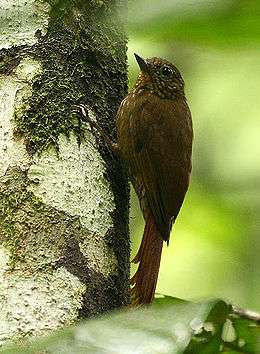Wedge-billed woodcreeper
| Wedge-billed woodcreeper | |
|---|---|
 | |
| at Rio Silanche (PVM), NW Ecuador | |
| Scientific classification | |
| Kingdom: | Animalia |
| Phylum: | Chordata |
| Class: | Aves |
| Order: | Passeriformes |
| Family: | Dendrocolaptidae |
| Genus: | Glyphorynchus Wied-Neuwied, 1831 |
| Species: | G. spirurus |
| Binomial name | |
| Glyphorynchus spirurus (Vieillot, 1819) | |
| Synonyms | |
|
Glyphorhynchus spirurus (lapsus) | |
The wedge-billed woodcreeper (Glyphorynchus spirurus), is a passerine bird which breeds in the tropical New World from southern Mexico to northern Bolivia, central Brazil and the Guianas; it is absent from the Pacific coastal areas except between Costa Rica and Ecuador. It is the only member of the genus Glyphorynchus.
It is easily distinguished from its relatives by its small size and distinctive bill. The wedge-billed woodcreeper is typically 14–15 cm long, and weighs 14–16.5 g. It has brown upperparts, with fine streaking on the head sides, a buff supercilium, and a chestnut rump, wings and tail. The throat is buff, and the rest of the underparts are brown spotted with buff chevrons, most heavily on the breast. A buff wing bar is obvious from below in flight. The short wedge-shaped bill is quite different in shape from that of other woodcreepers. Young birds are duller with less distinct breast streaking.
The call is a sneezy schip. The song varies geographically, perhaps reflecting the different subspecies of this bird. In Costa Rica it is a trilled keekekekiki, whilst in eastern Bolivia it is an ascending too-e too-e tu-tu-tu-tue-twu-twu-tweeet.
This common and widespread small woodcreeper is found in lowlands up to 1500 m altitude, although normally below 1100 m, in damp forests, adjacent semi-open woodland and old second growth. It feeds on small spiders and insects, creeping up trunks and extracting its tiny prey from the bark. It has a strong preference for trees with fine flaky bark. It is seen alone, in pairs, or sometimes as part of a mixed-species feeding flock. Birds are largely resident, but may disperse locally. For example, a vagrant individual was observed on May 12, 1998 at Cerro Campana, El Salvador, the first record for that country.[2]
It builds a cup nest in a narrow tree cavity such as a rotting stump or space between buttresses. It may occasionally nest up to 6 m high in a tree, but is usually much lower, often at or below ground level. It lays two white eggs between March and June.
Footnotes
- ↑ BirdLife International (2012). "Glyphorynchus spirurus". IUCN Red List of Threatened Species. Version 2013.2. International Union for Conservation of Nature. Retrieved 26 November 2013.
- ↑ Herrera et al. (2006)
References
- Herrera, Néstor; Rivera, Roberto; Ibarra Portillo, Ricardo & Rodríguez, Wilfredo (2006): Nuevos registros para la avifauna de El Salvador. ["New records for the avifauna of El Salvador"]. Boletín de la Sociedad Antioqueña de Ornitología 16(2): 1-19. [Spanish with English abstract] PDF fulltext
- Hilty, Steven L. (2003): Birds of Venezuela. Christopher Helm, London. ISBN 0-7136-6418-5
- Stiles, F. Gary & Skutch, Alexander Frank (1989): A guide to the birds of Costa Rica. Comistock, Ithaca. ISBN 0-8014-9600-4
